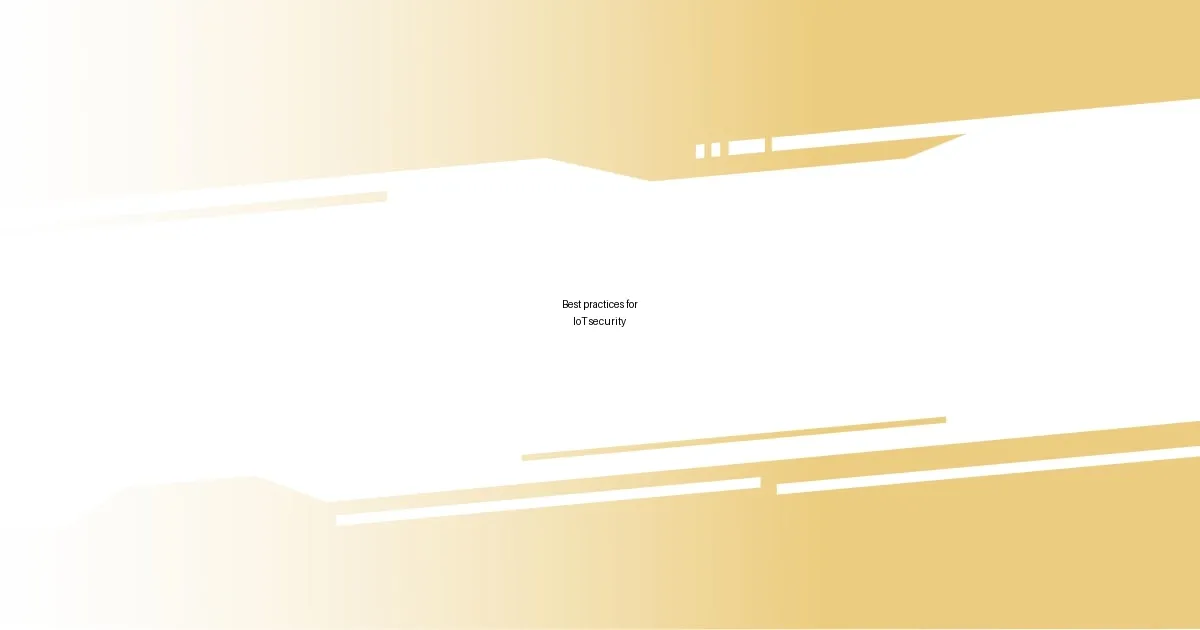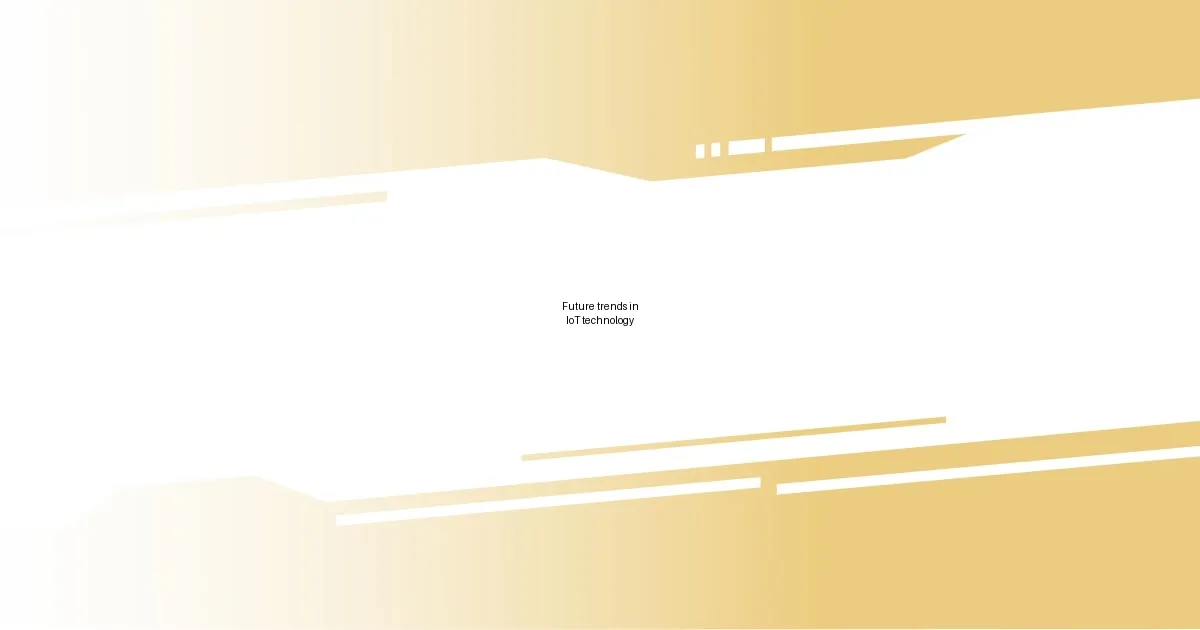Key takeaways:
- IoT devices connect everyday objects to the internet, enhancing convenience and control while raising privacy and security concerns.
- Common IoT devices include smart thermostats, speakers, wearables, security systems, and connected appliances that improve daily life.
- Security issues such as weak default passwords and lack of encryption highlight the importance of proper risk management for IoT devices.
- Future trends in IoT technology include AI integration, edge computing for faster performance, and a focus on enhanced security protocols.

Understanding IoT devices
Understanding IoT devices requires us to grasp the core idea behind them: the ability to connect everyday objects to the internet, allowing them to send and receive data. I remember the first time I connected my smart thermostat; it felt like I had stepped into the future. It wasn’t just about convenience; it was about controlling my environment with a few taps on my phone. Isn’t that a bit mind-blowing?
As I explored more IoT devices, I found that they often enhance our daily lives in unexpected ways. For instance, my smart refrigerator tracks expiration dates and sends me reminders. I never thought I’d be emotionally attached to an appliance, but here we are! It’s remarkable how these small innovations can reduce food waste and save money—who wouldn’t want that?
Consider the implications of so many devices communicating with each other. It raises questions about privacy, security, and data management. I sometimes wonder: how much data are we really comfortable sharing? It’s fascinating yet a bit unnerving. As we embrace this technology, we must also navigate these considerations thoughtfully.

Common types of IoT devices
Diving deeper into the world of IoT devices, I’ve come across several common types that not only simplify tasks but also add a new layer of awareness to our daily routines. From smart home gadgets that predict our preferences to wearable health trackers that keep an eye on our wellbeing, each device occupies a unique space in our lives. I recently discovered that my fitness tracker not only measures steps but also monitors my sleep patterns. It was enlightening to see how closely my physical activity correlates with my energy levels throughout the day.
Here are some prevalent types of IoT devices that you might encounter:
- Smart Thermostats: Learn your schedule and adjust temperatures accordingly for optimal comfort and energy savings.
- Smart Speakers: Voice-activated devices like Amazon Echo or Google Nest that play music, answer queries, and control other smart systems.
- Wearable Fitness Devices: Track health metrics such as heart rate, steps, and sleep quality, providing insights into personal wellness.
- Smart Home Security Systems: Enable homeowners to monitor their property remotely via cameras and alarms, enhancing safety.
- Connected Appliances: Such as smart refrigerators and ovens, which can optimize cooking and maintain food freshness and reduce waste.
Recollecting my own use of these devices, I can’t help but smile every time I set my coffee maker to brew while I’m still in bed. It feels like a small victory each morning!

Security issues with IoT devices
As I delve into security issues with IoT devices, I can’t help but feel a sense of unease. These devices are often created with convenience in mind, but that can lead to oversight when it comes to security features. For instance, after connecting my smart doorbell, I realized it had weak default passwords. It dawned on me that many users might not change them, leaving their homes vulnerable to intruders.
Additionally, the vast amount of data gathered by IoT devices raises privacy concerns. I remember setting up my smart TV and being surprised to learn it collects viewing habits and personal information. This was an eye-opener for me—I realized I was potentially sharing more than I intended. It’s vital for us to ask ourselves: are we aware of what our devices are learning about us?
The fact that many IoT devices lack robust encryption is alarming. While I enjoy the benefits of a smart thermostat that learns my preferences, I’ve become aware of the risks. For instance, if someone gains access to the thermostat, they could disrupt my home’s heating or cooling system. This highlights the importance of choosing devices that prioritize security features.
| Security Issue | Description |
|---|---|
| Default Password Vulnerabilities | Many IoT devices come with weak, unchangeable default passwords, allowing unauthorized access if not modified. |
| Data Privacy Concerns | IoT devices often collect personal data, which can be vulnerable to misuse if proper security measures aren’t in place. |
| Lack of Encryption | Numerous devices fail to implement strong encryption, putting sensitive information at risk of interception. |

Best practices for IoT security
When it comes to securing IoT devices, one of the most critical steps I recommend is changing the default passwords immediately upon setup. I remember setting up a smart lock and being startled to discover how easy it was for someone to override it with the factory settings. It made me realize—how much do we trust that others will do the same? Making passwords unique and complex not only protects our personal space but also ensures a foundational layer of security.
Another best practice is regularly updating device firmware. I used to neglect this with my smart lights until one day, I noticed they had developed strange connectivity issues. After a quick search, I found out there was a firmware update that fixed several vulnerabilities. The thought that I had potentially left my home exposed all that time really hit home. It’s a simple reminder that we often overlook, but staying on top of updates can significantly enhance device security.
Lastly, I have found that keeping an eye on connected devices within your network is invaluable. I once discovered an old security camera I had forgotten about was still streaming footage. That moment was a wake-up call—how many extra eyes are watching out there? Regularly reviewing and managing connected devices can help us maintain control over what’s on our network and bolster our overall security.

Future trends in IoT technology
As I consider the future trends in IoT technology, one standout development is the increasing integration of artificial intelligence (AI) within these devices. I recently upgraded my smart assistant, and the improvements in its ability to learn my habits were astonishing. It made me wonder: what if our devices could not only respond to our commands but also predict our needs? This evolution will not only enhance user experience but could drastically personalize how we interact with the technology around us.
Moreover, I’m particularly intrigued by the rise of edge computing. This trend means data processing happens closer to the device rather than relying solely on cloud services. I recall a time my smart camera lagged when trying to stream video to my phone. That delay prompted me to think about how relying on distant servers could hamper performance. With edge computing, I can envision quicker responses and reduced wait times, making my IoT devices feel more instantaneous and efficient.
Lastly, the focus on enhanced security protocols stands out as a crucial trend. Having experienced the discomfort of breaches with my previous devices, I understand the need for robust security measures. As manufacturers prioritize this aspect, it raises an important question: How will we, as consumers, adapt to these changes? My hope is that, with greater awareness of security advancements, we’ll cultivate a more proactive approach to protecting our digital environments.

How to choose IoT devices
Choosing the right IoT device can sometimes feel overwhelming, but I usually start by considering what exactly I need from a device. For instance, when I was looking for a smart thermostat, I realized I wanted more than just temperature control—I needed something that would integrate seamlessly with my other smart devices. It’s essential to clarify your priorities; otherwise, you might end up with a gadget that doesn’t quite fit your lifestyle.
Another important aspect to think about is compatibility. I made that mistake with a smart home assistant that didn’t play well with my existing lights, leading to hours of frustration. Researching how well devices communicate with each other beforehand can save you so much hassle in the long run. Have you ever faced a compatibility issue? It can turn an exciting upgrade into a tedious task.
Finally, I always check online reviews and user feedback. In my experience, the insight from other users is invaluable. I remember considering a smart lock that initially seemed perfect, but I stumbled upon several reviews highlighting connection issues. Hearing about others’ experiences often helped me narrow down my choices and avoid potential pitfalls. So, asking ourselves—how much do we trust marketing versus real-life experience? That question always guides my decision-making.














